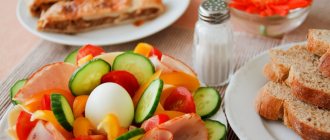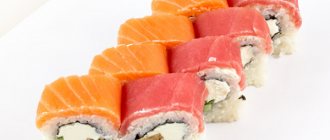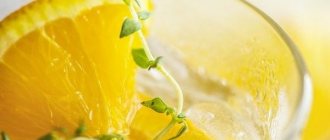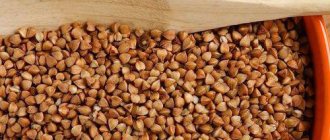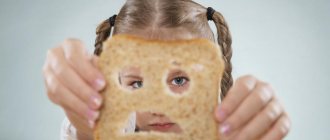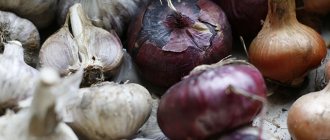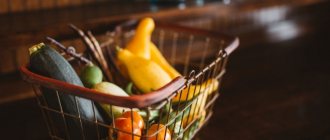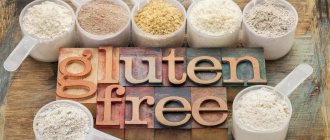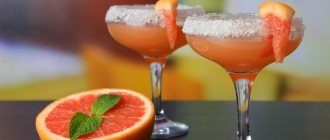General rules
A low-protein diet is recommended for kidney disease, and there is a reason for this. The kidneys ensure the constancy of the internal environment of the body, since one of their functions is to remove toxins , allergens and metabolic end products ( creatinine , urea and bilirubin ).
Chronic renal failure , which is based on the death of nephrons, leads to loss of filtration function of the kidneys. The main causes of renal failure are chronic kidney diseases ( glomerulonephritis , pyelonephritis , nephrosclerosis , which are collectively called “chronic kidney disease”), diabetes mellitus and arterial hypertension . Despite treatment, renal failure is irreversible, progresses and eventually enters the terminal stage.
With chronic renal failure, the filtration function suffers to varying degrees and breakdown products (uremic toxins) are not excreted from the body. The criteria for chronic renal failure are: blood urea and creatinine concentrations.
Creatinine is the end product of protein metabolism, which breaks down during muscle contractions. This is an important indicator of kidney function because creatinine is excreted in the urine. Urea is a nitrogen-containing breakdown product of proteins and, in general, its production is proportional to protein consumption: from 100 g of protein consumed, 30 g of urea is formed. In patients with chronic renal failure, it is possible to delay the period of increase in urea in the blood by reducing protein intake to 20–30 g per day.
In this regard, patients with renal failure are advised to eat a protein-restricted diet. The patient can consume such an amount of protein that will not cause an increase in azotemia . By limiting protein intake, the level of urea decreases, and the symptoms of uremic intoxication (nausea, vomiting, uremic gastritis, colitis, itching) disappear.
Diet can slow the progression of the disease and prolong the life of patients. The first stage of kidney damage is hyperfiltration (increased filtration), which is associated with an increase in the load on the glomeruli of the kidneys. Hyperfiltration is one of the mechanisms of progression of renal failure. Reducing the protein load inhibits it and, therefore, slows down the progression of the disease.
General nutrition rules:
- The main thing is to limit the consumption of animal protein.
- Reduce phosphorus-containing foods, salt and liquid. All dishes are prepared without salt and its consumption is allowed in the amount of 1.5–2.5 g per day in ready-made dishes.
- Fractional diet.
- Monitor potassium and magnesium intake.
- Increased energy value of the diet - at least 3000-3500 kcal due to fats and carbohydrates.
- Increase in unsaturated fatty acids (vegetable oils and nuts, if there are no restrictions on potassium and phosphorus).
- Adequate intake of vitamins.
- Culinary processing - baking, boiling, frying without a pronounced crust.
- Limit or eliminate nitrogenous extractives, strong coffee, alcohol, chocolate, tea, cocoa and salty snacks.
Patients can be prescribed Diets No. 7 , 7A , 7B , which differ in protein composition. In the initial stage of the disease, a protein content of 0.8 g/kg of weight is allowed. Regular bread is replaced with protein-free bread. The patient is recommended to have fasting days with a reduced amount of protein three times a week. Patients at this stage do not need additional intake of amino acid
For stage 2 chronic renal failure, protein is limited to 0.5-0.4 g/kg body weight. Due to the recommended phosphorus restriction, the patient should not consume legumes, poultry, egg yolks, nuts, cheeses, and milk in limited quantities.
To reduce phosphates in beef, rice, fish or potatoes, boil them several times, constantly draining the water. Due to the restriction of animal protein, amino acid supplements are prescribed (drug Ketosteril ). In addition to the fact that the drug is a supplier of essential amino acids, the calcium contained in it binds phosphates and is removed from the intestines.
The prescription of a diet containing 0.3 g of protein per kg of weight is indicated for stage 3 chronic renal failure.
In parallel, preparations of essential amino acids . The diet of patients includes foods with a small amount of protein, but high in calories - sago, protein-free bread, mashed potatoes with corn starch.
In case of disturbances in the electrolyte composition of the blood, limit the consumption of potassium (dried apricots, apricots, raisins, prunes, potatoes), magnesium (cereals, legumes, bran, fish, cottage cheese) and phosphates (cheeses and dairy products). In conditions of reduced protein intake in patients, it is necessary to maintain nitrogen balance.
Thanks to the variety and availability of foods with dosed protein content, the diet has become easy and not burdensome to follow. The dry mixture “Diso” “Nutrinor” contains 40 g of high-value protein per 100 g. The mixture in an amount of 9-28 g is introduced into a dish 3 minutes before readiness, for example, into porridge, soup or vegetable dishes.
Protein-free diet - nutrition principles and menu for the week
Despite the name, the main principle of a protein-free diet is not the exclusion of foods containing protein from the menu. On the contrary, to lose weight you need to consume protein, but in very limited quantities.
The list of allowed foods for a protein-free diet for weight loss includes:
- wheat bread, bran;
- soups with low-fat broth;
- lean meat and fish;
- eggs;
- low-fat cottage cheese and kefir;
- fruits vegetables;
- cereals;
- weak coffee and tea;
- juices and compotes.
As for the strictest prohibitions on a protein-free diet for weight loss, this list includes:
- meat broths;
- salt;
- fresh bread made from white flour.
If this amount of protein products seems not enough for you, turn to a protein diet for a week, where you can lose up to 6 kg.
Based on the above lists, with a special protein diet for weight loss, you can create the following menu for the week:
Monday
- Breakfast: cottage cheese, oatmeal and jam;
- Lunch: macaroni and cheese, sausages;
- Dinner: vegetables and diet bread.
Tuesday
- strawberries and cream, weak black coffee;
- millet porridge with prunes, orange juice;
- a sandwich of rye bread and processed cheese washed down with a glass of low-fat kefir.
Wednesday
- milk porridge with jam, lemon tea;
- stewed zucchini with peppers and tomatoes, apple compote;
- low-fat fish cutlets.
Thursday
- buckwheat and kefir;
- lettuce, carrot and cucumber;
- banana, strawberries and kiwi combined with low-fat yogurt.
Friday
- toast with honey, coffee with cream;
- millet porridge, tea;
- oatmeal with milk.
Saturday
- finely chopped cabbage, cucumbers and sour cream, washed down with a glass of kefir;
- boiled rice with low-fat fish cutlets;
- 250 g chicken meat and tomatoes.
Sunday
- carrot puree, apple compote;
- oatmeal and milk;
- fruits and weak black tea without sugar.
For kidney disease
Protein-free food restriction for weight loss is usually prescribed for various diseases, in order to improve blood circulation and stabilize the functioning of the digestive system. A protein-free diet for kidney disease is necessary for a balanced metabolism.
It is known that kidney failure will sooner or later lead to the destruction of the entire body. Therefore, in order to avoid this difficult fate, this dietary restriction is recommended for weight loss.
When consuming the recommended products in the menu of the above dietary restrictions for kidney disease, it is not recommended to take any medications, as they create unnecessary stress on this organ.
It is recommended to follow the diet for 1-2 weeks. If your health worsens, reduce fasting days to 1-2 times a week.
You should eat in fractional portions from 4 to 6 times a day, with a minimum calorie content of 3500. Limit salt, dried fruits, nuts, bananas and cottage cheese. The potassium and phosphorus contained in them increases the load on the kidneys.
Authorized Products
A low protein diet involves eating:
- Protein-free bread made from corn starch up to 300 g per day. This bread is also salt-free.
- Vegetarian cereal and vegetable soups in the amount of 250 ml per serving.
- Lean beef, chicken, turkey, boiled, as well as baked or fried after boiling, which removes nitrogenous substances. Average portion of meat 60 g.
- Low-fat fish - preparation methods and portions are the same.
- Vegetables - carrots, dill, cucumbers, cauliflower, green onions, lettuce, parsley, potatoes, cabbage. If a low-potassium diet is indicated for the patient, the vegetables are soaked, then boiled, draining the water several times, after which they can be stewed or baked.
- Cereals, legumes and pasta in limited quantities due to the content of protein, potassium and phosphorus. Sago dishes are recommended. Regular grains need to be soaked before cooking. Pasta and rice contain less potassium than potatoes.
- One egg white omelet.
- Berries and fruits in natural form and boiled. If it is necessary to limit potassium, fruits with a high potassium content (oranges, tangerines, bananas, dried apricots, raisins, figs) are sharply limited or excluded from the diet. The potassium content decreases slightly when fruit is boiled.
- Milk and fermented milk products, unless there are restrictions on phosphorus and protein. They can be consumed 200-300 g per day. You can consume cottage cheese in small quantities (up to 50 g), unless your doctor prescribes its exclusion.
- Weak tea, herbal teas, rosehip infusion. The possibility of drinking fruit juices due to the presence of potassium in them is discussed with your doctor.
- Unsalted butter and vegetable oils.
- Dishes are prepared without salt.
Table of permitted products
| Proteins, g | Fats, g | Carbohydrates, g | Calories, kcal | |
Vegetables and greens | ||||
| zucchini | 0,6 | 0,3 | 4,6 | 24 |
| cauliflower | 2,5 | 0,3 | 5,4 | 30 |
| potato | 2,0 | 0,4 | 18,1 | 80 |
| green onion | 1,3 | 0,0 | 4,6 | 19 |
| carrot | 1,3 | 0,1 | 6,9 | 32 |
| beet | 1,5 | 0,1 | 8,8 | 40 |
| celery | 0,9 | 0,1 | 2,1 | 12 |
| tomatoes | 0,6 | 0,2 | 4,2 | 20 |
| pumpkin | 1,3 | 0,3 | 7,7 | 28 |
| horseradish | 3,2 | 0,4 | 10,5 | 56 |
| garlic | 6,5 | 0,5 | 29,9 | 143 |
Fruits | ||||
| watermelon | 0,6 | 0,1 | 5,8 | 25 |
| melon | 0,6 | 0,3 | 7,4 | 33 |
| apples | 0,4 | 0,4 | 9,8 | 47 |
Berries | ||||
| strawberry | 0,8 | 0,4 | 7,5 | 41 |
Cereals and porridges | ||||
| buckwheat (kernel) | 12,6 | 3,3 | 62,1 | 313 |
| white rice | 6,7 | 0,7 | 78,9 | 344 |
| sago | 1,0 | 0,7 | 85,0 | 350 |
Confectionery | ||||
| jam | 0,3 | 0,2 | 63,0 | 263 |
| jelly | 2,7 | 0,0 | 17,9 | 79 |
| milk candies | 2,7 | 4,3 | 82,3 | 364 |
| fondant candies | 2,2 | 4,6 | 83,6 | 369 |
| paste | 0,5 | 0,0 | 80,8 | 310 |
Raw materials and seasonings | ||||
| mustard | 5,7 | 6,4 | 22,0 | 162 |
| cinnamon | 3,9 | 3,2 | 79,8 | 261 |
| honey | 0,8 | 0,0 | 81,5 | 329 |
| ground black pepper | 10,4 | 3,3 | 38,7 | 251 |
| dried parsley | 22,4 | 4,4 | 21,2 | 276 |
| sugar | 0,0 | 0,0 | 99,7 | 398 |
| milk sauce | 2,0 | 7,1 | 5,2 | 84 |
| sour cream sauce | 1,9 | 5,7 | 5,2 | 78 |
| caraway | 19,8 | 14,6 | 11,9 | 333 |
| dried dill | 2,5 | 0,5 | 6,3 | 40 |
Dairy | ||||
| milk | 3,2 | 3,6 | 4,8 | 64 |
| kefir | 3,4 | 2,0 | 4,7 | 51 |
| cream | 2,8 | 20,0 | 3,7 | 205 |
| sour cream | 2,8 | 20,0 | 3,2 | 206 |
| curdled milk | 2,9 | 2,5 | 4,1 | 53 |
| acidophilus | 2,8 | 3,2 | 3,8 | 57 |
| yogurt | 4,3 | 2,0 | 6,2 | 60 |
Meat products | ||||
| boiled beef | 25,8 | 16,8 | 0,0 | 254 |
| boiled beef tongue | 23,9 | 15,0 | 0,0 | 231 |
| boiled veal | 30,7 | 0,9 | 0,0 | 131 |
| rabbit | 21,0 | 8,0 | 0,0 | 156 |
Bird | ||||
| boiled chicken | 25,2 | 7,4 | 0,0 | 170 |
| turkey | 19,2 | 0,7 | 0,0 | 84 |
Eggs | ||||
| chicken eggs | 12,7 | 10,9 | 0,7 | 157 |
Oils and fats | ||||
| corn oil | 0,0 | 99,9 | 0,0 | 899 |
| olive oil | 0,0 | 99,8 | 0,0 | 898 |
| sunflower oil | 0,0 | 99,9 | 0,0 | 899 |
| ghee | 0,2 | 99,0 | 0,0 | 892 |
Non-alcoholic drinks | ||||
| mineral water | 0,0 | 0,0 | 0,0 | — |
| black tea with milk and sugar | 0,7 | 0,8 | 8,2 | 43 |
Juices and compotes | ||||
| apricot juice | 0,9 | 0,1 | 9,0 | 38 |
| carrot juice | 1,1 | 0,1 | 6,4 | 28 |
| pumpkin juice | 0,0 | 0,0 | 9,0 | 38 |
| * data is per 100 g of product | ||||
Fully or partially limited products
- Broths (fish, meat and mushroom).
- Animal fats.
- Salty products: canned food, cheeses, chips, sausages, sauces, ketchups, salted nuts, marinades, soup concentrates, bouillon cubes, margarine, salted butter.
- Potassium-containing foods: sorrel, bananas, coffee, milk powder, millet porridge, curry, fruit juices, fish, meat, chocolate, rhubarb, avocado, seeds, sesame, dried fruits, potatoes, many nuts (primarily almonds, peanuts, pine nuts) , peanut butter and paste, wine, beer, parsley, tomatoes (and products made from them - ketchup, sauce, juice), spinach, apple juice and syrup, beets, artichokes, soy products, soybeans, mushrooms, beans, lentils.
- Phosphorus-containing products: milk, cheeses, liver, kidneys, fish, fish caviar, chocolate, mushrooms, bran, nuts, seeds.
- Alcohol and carbonated drinks.
Table of prohibited products
| Proteins, g | Fats, g | Carbohydrates, g | Calories, kcal | |
Vegetables and greens | ||||
| vegetables legumes | 9,1 | 1,6 | 27,0 | 168 |
| sauerkraut | 1,8 | 0,1 | 4,4 | 19 |
| bulb onions | 1,4 | 0,0 | 10,4 | 41 |
| canned cucumbers | 2,8 | 0,0 | 1,3 | 16 |
| pickles | 0,8 | 0,1 | 1,7 | 11 |
| radish | 1,2 | 0,1 | 3,4 | 19 |
| white radish | 1,4 | 0,0 | 4,1 | 21 |
| turnip | 1,5 | 0,1 | 6,2 | 30 |
| tomatoes | 0,6 | 0,2 | 4,2 | 20 |
| canned tomatoes | 1,1 | 0,1 | 3,5 | 20 |
| spinach | 2,9 | 0,3 | 2,0 | 22 |
| sorrel | 1,5 | 0,3 | 2,9 | 19 |
Fruits | ||||
| apricots | 0,9 | 0,1 | 10,8 | 41 |
| bananas | 1,5 | 0,2 | 21,8 | 95 |
| figs | 0,7 | 0,2 | 13,7 | 49 |
| nectarine | 0,9 | 0,2 | 11,8 | 48 |
| peaches | 0,9 | 0,1 | 11,3 | 46 |
Mushrooms | ||||
| mushrooms | 3,5 | 2,0 | 2,5 | 30 |
| marinated mushrooms | 2,2 | 0,4 | 0,0 | 20 |
Nuts and dried fruits | ||||
| raisin | 2,9 | 0,6 | 66,0 | 264 |
| dried apricots | 5,2 | 0,3 | 51,0 | 215 |
| dried apricots | 5,0 | 0,4 | 50,6 | 213 |
| dates | 2,5 | 0,5 | 69,2 | 274 |
Cereals and porridges | ||||
| semolina | 10,3 | 1,0 | 73,3 | 328 |
| cereals | 11,9 | 7,2 | 69,3 | 366 |
| corn grits | 8,3 | 1,2 | 75,0 | 337 |
| pearl barley | 9,3 | 1,1 | 73,7 | 320 |
| millet cereal | 11,5 | 3,3 | 69,3 | 348 |
Flour and pasta | ||||
| pasta | 10,4 | 1,1 | 69,7 | 337 |
Chocolate | ||||
| chocolate | 5,4 | 35,3 | 56,5 | 544 |
Raw materials and seasonings | ||||
| ginger | 1,8 | 0,8 | 15,8 | 80 |
| ketchup | 1,8 | 1,0 | 22,2 | 93 |
| mayonnaise | 2,4 | 67,0 | 3,9 | 627 |
| tomato sauce | 1,7 | 7,8 | 4,5 | 80 |
Meat products | ||||
| pork | 16,0 | 21,6 | 0,0 | 259 |
| salo | 2,4 | 89,0 | 0,0 | 797 |
Bird | ||||
| smoked chicken | 27,5 | 8,2 | 0,0 | 184 |
| duck | 16,5 | 61,2 | 0,0 | 346 |
| smoked duck | 19,0 | 28,4 | 0,0 | 337 |
| goose | 16,1 | 33,3 | 0,0 | 364 |
Fish and seafood | ||||
| dried fish | 17,5 | 4,6 | 0,0 | 139 |
| smoked fish | 26,8 | 9,9 | 0,0 | 196 |
| black caviar | 28,0 | 9,7 | 0,0 | 203 |
| salmon caviar granular | 32,0 | 15,0 | 0,0 | 263 |
| canned fish | 17,5 | 2,0 | 0,0 | 88 |
Oils and fats | ||||
| animal fat | 0,0 | 99,7 | 0,0 | 897 |
| cooking fat | 0,0 | 99,7 | 0,0 | 897 |
Juices and compotes | ||||
| tomato juice | 1,1 | 0,2 | 3,8 | 21 |
| * data is per 100 g of product | ||||
Menu (Power Mode)
Strict compliance with the requirements and calculation of the amount of protein, potassium and phosphorus makes it possible to improve the patient’s quality of life and extend the dialysis-free period. For calculations, patients use tables of protein, phosphorus and potassium content in foods.
Six grams of animal protein are contained in: one egg, 30 g of fish, 25 g of meat, 60 g of sour cream, 25 g of cheese, 150 g of yogurt and 25 g of seafood. Two grams of vegetable protein contain 120 g of potatoes, 150 g of oatmeal and 100 g of rice. To add flavor to food, you can use small amounts of dill, bay leaf, parsley, basil, cinnamon, onion, cloves or garlic. You can use low-protein products: amylopectin starch, sago, bread made from maize starch.
It is impossible to create a universal menu suitable for all patients, since the degree of azotemia and disturbances in phosphorus-potassium metabolism are different for everyone. When drawing up a menu, you need to base it on the doctor’s recommendation. An approximate menu for Table 7B might look like this:
| Breakfast |
|
| Lunch |
|
| Dinner |
|
| Afternoon snack |
|
| Dinner |
|
| For the night |
|
| Breakfast |
|
| Lunch |
|
| Dinner |
|
| Afternoon snack |
|
| Dinner |
|
| For the night |
|
| Breakfast |
|
| Lunch |
|
| Dinner |
|
| Afternoon snack |
|
| Dinner |
|
| For the night |
|
Protein-free diet: menu for the week
In this version of the diet, fats of animal origin, dairy products with a high percentage of fat content, ordinary bread and salt are excluded.
| Day | Breakfast | Dinner | Dinner |
| Monday | Oatmeal with strawberry jam | Vegetable soup, bread, a glass of tomato juice | Baked fish, lettuce with sliced cucumber. |
| Tuesday | Buckwheat with onions, berry compote | Stewed eggplants with carrots, tomato salad, pear | A piece of boiled turkey, a glass of kefir |
| Wednesday | Millet porridge with dried apricots, tea with lemon | Borscht, croutons, apple compote | Steamed fish cutlets, grated carrots |
| Thursday | Boiled egg, glass of natural yogurt (0%) | Baked peppers with rice, 2 slices of rye bread, jelly | Stewed cabbage, peaches |
| Friday | Milk porridge, bran bread with honey, tea | Celery soup with potatoes, bread, 2 kiwis | Baked zucchini, fruit |
| Saturday | Carrot casserole, green tea | Barley, steamed turkey cutlets, compote | Rabbit fillet, beet salad |
| Sunday | Cereals with milk | Ukha, fresh vegetable salad with vegetable oil | Cauliflower Casserole |
Be sure to read: Korean idol diet (k-pop diet), how stars lose weight
Low protein diet recipes for kidney disease
In the initial form of chronic renal failure, the method of cooking does not matter - frying, boiling and baking are allowed. In case of severe renal failure, when it is necessary to limit potassium, the products must first be boiled. Thus, its content is reduced by almost half (the microelement passes into water).
Potatoes, beets, eggplants and zucchini are rich in potassium, so they are peeled and pre-boiled. In the future, use it at your own discretion. Those suffering from kidney failure can use seasonings and spices - pepper, vinegar, mustard, herbs.
Compote must be prepared from apples and pears; it is not allowed to add dried apricots and raisins to the decoctions due to the high potassium content. In the non-dialysis period for stage 2 chronic renal failure, a diet with 0.6 g/kg of protein is recommended, half of which should be animal proteins. The usual serving of meat or fish is 50 g per day.
Patients can use sago cereal - it contains only 1 g of protein, has no taste and absorbs the flavors of other foods well. It can be combined with rice, herbs and spices, meat products and vegetables. The sago is soaked overnight and boiled for 30-40 minutes in the morning. After this, discard in a colander, rinse and lightly dry. The finished porridge can be stored in the refrigerator and used as needed.
First meal
Vegetarian borscht
Boil the peeled beets until half cooked, remove and grate them. Stew onion, tomato and grated carrots in vegetable oil. Dip the prepared potatoes (soaked) into the beet broth. Boil for 15 minutes and add the chopped cabbage, and after 3 minutes add the stewed vegetables. Season the dish with herbs and sour cream.
Second courses
Sago and rice milk porridge
Take equal quantities of rice and sago, previously soaked. Pour water in a ratio of 1:2 and put on fire. Cook over low heat for about 45 minutes. Add a glass of milk, sugar to the finished porridge and bring to a boil. Serve with butter.
Sago with meat
Prepare a portion of sago or use pre-prepared porridge. Heat it in a water bath. Separately, cook the beef, draining the water. Take 50 g of meat per serving, you can mince it, lightly fry it with onions and mix the resulting minced meat with sago.
Potato zrazy with cabbage
Peel the potatoes, cut into pieces and soak for an hour. Boil, cool and grind thoroughly (you can use a meat grinder). Separately, stew the white cabbage, adding bay leaf, pepper and dill. Make a flat cake from the potato mixture, put minced cabbage on it and seal the edges, giving the zrazas the shape of a pie. Fry in vegetable oil. Can be served with sour cream.
Dessert
Carrot cutlets
Peel and boil the carrots. Grate the cooled mixture on a fine grater. Add sugar, 2 tbsp. l. semolina, mix well and let stand for the cereal to swell. Make cutlets from the resulting mass. Fry in vegetable oil on both sides until browned. Serve with sour cream.
How to make a menu correctly
When starting any diet, it can be quite difficult to get started. The whole difficulty lies in studying the permitted products and forming from them a suitable menu that meets the goals of adhering to a certain nutritional system. To simplify this task, you can first use the basic diet options.
If a person nevertheless decides to go on a protein-free diet for weight loss, his menu for the week will consist of small mono-diets.
- Monday and Tuesday are a vegetable feast. During this period, you can eat up to 2 kg of cucumbers, tomatoes, peppers, etc.
- Wednesday is dedicated to pears and apples. Including them in your diet will improve your metabolism.
- Thursday will consist exclusively of steamed vegetables and jam.
- On Friday and Saturday you can eat yogurt, vegetables and dishes made from them.
- Sunday – we eat only greens and vegetables.
Such a strict regime can help you get rid of 7 to 10 kg per week, but health problems cannot be ruled out.
Following a low-protein diet for medicinal purposes can begin with the following menu:
| Category of people | Breakfast | Lunch | Dinner | Dinner |
| With kidney diseases (weight loss by 5-7 kg) | 2 eggs (white) + 2 tomatoes + 200 ml milk. | Dried fruits. | Vegetable stews or fruit salads. | Vegetable salad. |
| With cancer (2 weeks) | 100 gr. buckwheat porridge on water. | Apples. | Bread with boiled vegetables. | Buckwheat porridge + 2 tomatoes. |
| Diabetics (no more than 1 time in 2 months) | Cabbage salad + tea. | Tomato or cucumber. | Pasta + boiled vegetables. | Beet salad dressed with vegetable oil. |
| With rheumatoid arthritis (2 weeks) | Buckwheat porridge with milk + 1 carrot cutlet + a cup of tea without sugar. | Fruits or vegetables. | 2 boiled potatoes + vegetable soup + compote. | Lenten pilaf + vegetable salad + a cup of jelly. |
| Pregnant women (2 weeks; minus 5 kg) | 100 gr. buckwheat porridge + 2 apples. | Yogurt. | Pancakes + pasta + milk. | Vegetable stew or salad. |
| Nursing mothers (no more than 1 week; up to 4 kg may be lost) | 100 gr. semolina or buckwheat porridge with milk + jelly. | Fruits or vegetables. | 2 boiled potatoes + lean soup. | Vegetable salad. |
Reviews and results
This diet is not easy to follow because it has many restrictions and takes into account many nutritional factors. But such nutrition is a vital necessity for patients. Strict control of potassium and phosphorus adds further restrictions. However, patients have adapted to such a dietary diet, supplement it with protein-free foods and amino acid , and consider unsalted and tasteless dishes to be the only drawback.
- “... High blood pressure and creatinine forced me to make adjustments to my diet. Only diet helps. At this stage, I sharply limited the salt, removed cottage cheese and cheese, I don’t eat fish - I don’t like it. I limited my meat a little (at the expense of pork and beef, I’m generally indifferent to meat). Main food: potatoes, rice, cabbage, zucchini, rolled oats, butter and vegetable oil, I drink milk, but not every day. I really love vegetables in any form (cutlets, casseroles, stews, purees) and they help me out. The course of chronic renal failure will make adjustments and it will be clear what to do next”;
- “... I’ve already adapted to this diet. For breakfast - rolled oats with water, add honey, a little apple, I can make an omelet or milk rice porridge or sago. I buy homemade unleavened cheese (like Adyghe cheese) and tea. For lunch I cook boiled meat or bake it. As a side dish I use rice, buckwheat, stewed cabbage or zucchini. I add pepper, onion, garlic, and basil to all dishes. For now, I don’t limit vegetables and fruits, except for the leaders in potassium (bananas, dried apricots, dates, raisins). I go on business trips and even there I solve the nutrition problem: I take food in containers (rice and boiled chicken/turkey). Of course, I want meat, but I can’t have too much, so I add just a spoonful of minced meat to the porridge. I can only eat 50 g of meat per day. I don’t count anything other than protein. It's good that low-protein foods exist and this allows you to eat better and follow a diet. I buy protein-free flour and bake my own bread, cereals, pasta, and cookies. Pasta tastes no different from regular pasta. I use scales that calculate the content of foods based on protein, salt, fats, carbohydrates, and show calories. Potassium, if necessary, can be taken from the tables. Thus, for health reasons I have been at the same level for 4 years already”;
- “... Nutrition for chronic renal failure is very important. Previously, I only limited protein, but now the potassium level has increased, and the doctor said to be sure to take this into account. Therefore, I excluded tomatoes, peppers, chocolate, bananas, dried fruits, citrus fruits - I can only add a slice of lemon, a slice of orange or tangerine to tea. I eat eggplants, but I soak them in salt water for 30 minutes, they release juice and lose microelements. Then I fill it with fresh water, soak it and squeeze it out. I do the same with cabbage. I eat unsalted, several times boiled rice with zucchini or nori. For taste, I sprinkle with turmeric, green onions and sunflower oil. I also eat buckwheat and corn porridge - there is more protein than in rice, but there is less phosphorus. I mix calcium carbonate with food and drink Ketosteril 12 tablets a day. He doesn’t make me want to eat.”
